Cross-Scale Interactions and Information Transfer
Abstract
:1. Introduction
- (1)
- The cause occurs before the effect; and
- (2)
- The cause contains information about the effect that is unique, and is in no other variable.
2. Overview of Methods
2.1. Measuring Dependence with Mutual Information
- I(X; Y ) ≥ 0,
- I(X; Y ) = 0 iff X and Y are independent.
2.2. Inference of Causality with the Conditional Mutual Information
2.3. Example: Unidirectionally Coupled Rössler Systems
2.4. Interactions over Time Scales
- phase–phase
- amplitude–amplitude
- phase–amplitude
2.5. Statistical Evaluation with Surrogate Data
 /2 are obtained by multiplying n coefficients on the scale
/2 are obtained by multiplying n coefficients on the scale
 by a set of multiplicators, randomly drawn from a given distribution. After the construction of such a dyadic tree (always two different random multipliers are chosen in order to obtain two wavelet coefficients on a shorter scale from one wavelet coefficient on the closest larger scale), the inverse discrete wavelet transform produces a realization of a multifractal process mimicking information transfer from larger to smaller scales observed in turbulence. For construction of the multifractal surrogate data, a time series is transformed into a set of discrete wavelet coefficients and multipliers are computed by dividing each pair of coefficients on the scale
by a set of multiplicators, randomly drawn from a given distribution. After the construction of such a dyadic tree (always two different random multipliers are chosen in order to obtain two wavelet coefficients on a shorter scale from one wavelet coefficient on the closest larger scale), the inverse discrete wavelet transform produces a realization of a multifractal process mimicking information transfer from larger to smaller scales observed in turbulence. For construction of the multifractal surrogate data, a time series is transformed into a set of discrete wavelet coefficients and multipliers are computed by dividing each pair of coefficients on the scale
 /2 by the related coefficient on the scale
/2 by the related coefficient on the scale
 . Then, fixing one or two largest scales, the surrogate wavelet coefficients are recursively computed from larger to smaller scales using randomly permutated original multipliers. See [42] for details.
. Then, fixing one or two largest scales, the surrogate wavelet coefficients are recursively computed from larger to smaller scales using randomly permutated original multipliers. See [42] for details.3. Results and Discussion
3.1. Coping with Method Errors
 to a scale
to a scale
 /2, or from a time scale characterized by a frequency f to a time scale characterized by a frequency 2f. This information transfer does not reach over the closest smaller scale, i.e., it is restricted to the transfer of information from a certain scale to the next smaller scale approximately equal to one half of the preceding scale, exactly in the way how this realization of a multifractal process was constructed. This numerical construction based on the discrete wavelet transform (described above and in detail in [42]) uses scales given by the consecutive powers of two (2, 4, 8, 16, ... samples), while in the analysis we use the continuous (complex) wavelet transform that gives the possibility to study scales given by real numbers (limited by the available data). A closer look at Figure 5d reveals that there is no significant CMI at scales in the exact ratio 2:1. Apparently, the phases in the exact ratio 2:1 appear as phase-synchronized and the direction of coupling is not identifiable. However, there is always a range of close scales in which the significant CMI confirms the information transfer from scales close to
/2, or from a time scale characterized by a frequency f to a time scale characterized by a frequency 2f. This information transfer does not reach over the closest smaller scale, i.e., it is restricted to the transfer of information from a certain scale to the next smaller scale approximately equal to one half of the preceding scale, exactly in the way how this realization of a multifractal process was constructed. This numerical construction based on the discrete wavelet transform (described above and in detail in [42]) uses scales given by the consecutive powers of two (2, 4, 8, 16, ... samples), while in the analysis we use the continuous (complex) wavelet transform that gives the possibility to study scales given by real numbers (limited by the available data). A closer look at Figure 5d reveals that there is no significant CMI at scales in the exact ratio 2:1. Apparently, the phases in the exact ratio 2:1 appear as phase-synchronized and the direction of coupling is not identifiable. However, there is always a range of close scales in which the significant CMI confirms the information transfer from scales close to
 to scales close to
to scales close to
 /2, e.g., there is no significant CMI for the scales 16:8, but for the scales in ratios such as 15.488:8.712 the CMI is statistically significant (Figure 5d).
/2, e.g., there is no significant CMI for the scales 16:8, but for the scales in ratios such as 15.488:8.712 the CMI is statistically significant (Figure 5d).3.2. Cross-Scale Information Transfer in Atmospheric Dynamics
4. Conclusions
Acknowledgments
Conflicts of Interest
References
- Pikovsky, A.; Rosenblum, M.; Kurths, J. Synchronization. A Universal Concept in Nonlinear Sciences; Cambridge University Press: Cambridge, UK, 2001. [Google Scholar]
- Schäfer, C.; Rosenblum, M.G.; Kurths, J.; Abel, H.H. Heartbeat synchronized with ventilation. Nature 1998, 392, 239–240. [Google Scholar]
- Paluš, M.; Hoyer, D. Detecting nonlinearity and phase synchronization with surrogate data. IEEE Eng. Med. Biol. Mag 1998, 17, 40–45. [Google Scholar]
- Rodriguez, E.; George, N.; Lachaux, J.P.; Martinerie, J.; Renault, B.; Varela, F.J. Perception’s shadow: Long distance synchronization of human brain activity. Nature 1999, 397, 430–433. [Google Scholar]
- Paluš, M.; Komárek, V.; Hrnčíř, Z.; Štěrbová,, K. Synchronization as adjustment of information rates: Detection from bivariate time series. Phys. Rev. E 2001, 63, 046211. [Google Scholar]
- Paluš, M.; Komárek, V.; Procházka, T.; Hrnčíř, Z.; Štěrbová,, K. Synchronization and information flow in EEGs of epileptic patients. IEEE Eng. Med. Biol. Mag 2001, 20, 65–71. [Google Scholar]
- Lehnertz, K.; Bialonski, S.; Horstmann, M.T.; Krug, D.; Rothkegel, A.; Staniek, M.; Wagner, T. Synchronization phenomena in human epileptic brain networks. J. Neurosci. Methods 2009, 183, 42–48. [Google Scholar]
- Rybski, D.; Havlin, S.; Bunde, A. Phase synchronization in temperature and precipitation records. Phys. A 2003, 320, 601–610. [Google Scholar]
- Paluš, M.; Novotná, D. Quasi-biennial oscillations extracted from the monthly NAO index and temperature records are phase-synchronized. Nonlin. Processes Geophys 2006, 13, 287–296. [Google Scholar]
- Paluš, M.; Novotná, D. Phase-coherent oscillatory modes in solar and geomagnetic activity and climate variability. J. Atmos. Sol.-Terr. Phys 2009, 71, 923–930. [Google Scholar]
- Feliks, Y.; Ghil, M.; Robertson, A.W. Oscillatory climate modes in the Eastern Mediterranean and their synchronization with the North Atlantic Oscillation. J. Clim 2010, 23, 4060–4079. [Google Scholar]
- Paluš, M.; Novotná, D. Northern Hemisphere patterns of phase coherence between solar/geomagnetic activity and NCEP/NCAR and ERA40 near-surface air temperature in period 7–8 years oscillatory modes. Nonlin. Processes Geophys 2011, 18, 251–260. [Google Scholar]
- Feliks, Y.; Groth, A.; Robertson, A.W.; Ghil, M. Oscillatory climate modes in the Indian monsoon, North Atlantic, and Tropical Pacific. J. Clim 2013, 26, 9528–9544. [Google Scholar]
- Hlaváčková-Schindler, K.; Paluš, M.; Vejmelka, M.; Bhattacharya, J. Causality detection based on information-theoretic approaches in time series analysis. Phys. Rep 2007, 441, 1–46. [Google Scholar]
- Wiener, N. The theory of prediction. In Modern Mathematics for Engineers; Beckenbach, E., Ed.; McGraw-Hill: New York NY, USA, 1956. [Google Scholar]
- Granger, C.W.J. Time series analysis, cointegration, and applications. In Les Prix Nobel. The Nobel Prizes 2003; Frängsmyr, T., Ed.; Nobel Foundation: Stockholm, Sweden, 2004; pp. 360–366. [Google Scholar]
- Granger, C.W.J. Investigating causal relations by econometric models and cross spectral models. Econometrica 1969, 37, 424–438. [Google Scholar]
- Cover, T.; Thomas, J. Elements of Information Theory; J. Wiley: New York, NY, USA, 1991. [Google Scholar]
- Schreiber, T. Measuring information transfer. Phys. Rev. Lett 2000, 85, 461–464. [Google Scholar]
- Barnett, L.; Barrett, A.B.; Seth, A.K. Granger causality and transfer entropy are equivalent for Gaussian variables. Phys. Rev. Lett 2009, 103, 238701. [Google Scholar]
- Runge, J.; Heitzig, J.; Petoukhov, V.; Kurths, J. Escaping the curse of dimensionality in estimating multivariate transfer entropy. Phys. Rev. Lett 2012, 108, 258701. [Google Scholar]
- Kugiumtzis, D. Direct-coupling information measure from nonuniform embedding. Phys. Rev. E 2013, 87, 062918. [Google Scholar]
- Sun, J.; Bollt, E.M. Causation entropy identifies indirect influences, dominance of neighbors and anticipatory couplings. Phys. D 2014, 267, 49–57. [Google Scholar]
- Arnhold, J.; Grassberger, P.; Lehnertz, K.; Elger, C. A robust method for detecting interdependences: Application to intracranially recorded EEG. Phys. D 1999, 134, 419–430. [Google Scholar]
- Quiroga, R.Q.; Arnhold, J.; Grassberger, P. Learning driver-response relationships from synchronization patterns. Phys. Rev. E 2000, 61, 5142–5148. [Google Scholar]
- Paluš, M.; Vejmelka, M. Directionality of coupling from bivariate time series: How to avoid false causalities and missed connections. Phys. Rev. E 2007, 75, 056211. [Google Scholar]
- Chicharro, D.; Andrzejak, R.G. Reliable detection of directional couplings using rank statistics. Phys. Rev. E 2009, 80, 026217. [Google Scholar]
- Sugihara, G.; May, R.; Ye, H.; Hsieh, C.h.; Deyle, E.; Fogarty, M.; Munch,, S. Detecting Causality in Complex Ecosystems. Science 2012, 338, 496–500. [Google Scholar]
- Paluš, M. Detecting nonlinearity in multivariate time series. Phys. Lett. A 1996, 213, 138–147. [Google Scholar]
- Paluš, M.; Albrecht, V.; Dvořák, I. Information theoretic test for nonlinearity in time series. Phys. Lett. A 1993, 175, 203–209. [Google Scholar]
- Takens, F. Detecting strange attractors in turbulence. In Dynamical Systems and Turbulence, Warwick 1980; Rand, D.A., Young, L.S., Eds.; Lecture Notes in Mathematics; Springer: Berlin, Germany, 1981; Volume 898, pp. 366–381. [Google Scholar]
- Kocarev, L.; Parlitz, U. Generalized synchronization, predictability, and equivalence of unidirectionally coupled dynamical systems. Phys. Rev. Lett 1996, 76, 1816–1819. [Google Scholar]
- Fraser, A.M.; Swinney, H.L. Independent coordinates for strange attractors from mutual information. Phys. Rev. A 1986, 33, 1134–1140. [Google Scholar]
- Gans, F.; Schumann, A.Y.; Kantelhardt, J.W.; Penzel, T.; Fietze, I. Cross-modulated amplitudes and frequencies characterize interacting components in complex systems. Phys. Rev. Lett 2009, 102, 098701. [Google Scholar]
- Heil, C.; Walnut, D. Continuous and discrete wavelet transforms. SIAM Rev 1989, 31, 628–666. [Google Scholar]
- Huang, N.E.; Wu, Z. A review on Hilbert-Huang transform: Method and its applications to geophysical studies. Rev. Geophys 2008, 46. [Google Scholar] [CrossRef]
- Paluš, M.; Novotná, D. Enhanced Monte Carlo Singular System Analysis and detection of period 7.8 years oscillatory modes in the monthly NAO index and temperature records. Nonlin. Processes Geophys 2004, 11, 721–729. [Google Scholar]
- Paluš, M.; Novotná, D.; Tichavský, P. Shifts of seasons at the European mid-latitudes: Natural fluctuations correlated with the North Atlantic Oscillation. Geophys. Res. Lett 2005, 32, L12805. [Google Scholar]
- Torrence, C.; Compo, G.P. A practical guide to wavelet analysis. Bull. Am. Meteorol. Soc 1998, 79, 61–78. [Google Scholar]
- Jirsa, V.; Müller, V. Cross-frequency coupling in real and virtual brain networks. Front. Comput. Neurosci 2013, 7. [Google Scholar] [CrossRef]
- Theiler, J.; Eubank, S.; Longtin, A.; Galdrikian, B.; Farmer, J.D. Testing for nonlinearity in time series: the method of surrogate data. Phys. D 1992, 58, 77–94. [Google Scholar]
- Paluš, M. Bootstrapping multifractals: Surrogate data from random cascades on wavelet dyadic trees. Phys. Rev. Lett 2008, 101, 134101. [Google Scholar]
- Press, W.H.; Flannery, B.P.; Teukolsky, S.A.; Vetterling, W.T. Numerical Recipes: The Art of Scientific Computing; Cambridge University Press: Cambridge, UK, 1986. [Google Scholar]
- Benzi, R.; Biferale, L.; Crisanti, A.; Paladin, G.; Vergassola, M.; Vulpiani, A. A random process for the construction of multiaffine fields. Phys. D 1993, 65, 352–358. [Google Scholar]
- Arneodo, A.; Bacry, E.; Muzy, J.F. Random cascades on wavelet dyadic trees. J. Math. Phys 1998, 39. [Google Scholar] [CrossRef]
- Vejmelka, M.; Paluš, M. Inferring the directionality of coupling with conditional mutual information. Phys. Rev. E 2008, 77, 026214. [Google Scholar]
- Paluš, M. Testing for nonlinearity using redundancies—quantitative and qualitative aspects. Phys. D 1995, 80, 186–205. [Google Scholar]
- Nicolis, C.; Nicolis, G. Is there a climatic attractor? Nature 1984, 311, 529–532. [Google Scholar]
- Nicolis, C.; Nicolis, G. Evidence for climatic attractor. Nature 1987, 326, 529–532. [Google Scholar]
- Fraedrich, K. Estimating the dimensions of weather and climate attractors. J. Atmos. Sci 1986, 43, 419–432. [Google Scholar]
- Tsonis, A.A.; Elsner, J.B. The weather attractor over very short timescales. Nature 1988, 333, 545–547. [Google Scholar]
- Grassberger, P. Do climatic attractors exist? Nature 1986, 323, 609–612. [Google Scholar]
- Lorenz, E.N. Dimension of weather and climate attractors. Nature 1991, 353, 241–244. [Google Scholar]
- Paluš, M.; Novotná, D. Testing for nonlinearity in weather records. Phys. Lett. A 1994, 193, 67–74. [Google Scholar]
- Hlinka, J.; Hartman, D.; Vejmelka, M.; Novotná, D.; Paluš, M. Non-linear dependence and teleconnections in climate data: Sources, relevance, nonstationarity. Clim. Dyn 2014, 42, 1873–1886. [Google Scholar]
- Tsonis, A.A.; Elsner, J.B. Chaos, strange attractors, and weather. Bull. Am. Meteorol. Soc 1989, 70, 14–23. [Google Scholar]
- Tsonis, A.A. Climate Subsystems: Pacemakers of Decadal Climate Variability. In Extreme Events and Natural Hazards: The Complexity Perspective; Sharma, A.S., Bunde, A., Dimri, V.P., Baker, D.N., Eds.; American Geophysical Union: Washington D. C., USA, 2012; pp. 191–208. [Google Scholar]
- Vejmelka, M.; Pokorná, L.; Hlinka, J.; Hartman, D.; Jajcay, N.; Paluš, M. Non-random correlation structures and dimensionality reduction in multivariate climate data. Clim. Dyn 2014. [Google Scholar] [CrossRef]
- Tsonis, A.; Wang, G.; Swanson, K.; Rodrigues, F.; Costa, L. Community structure and dynamics in climate networks. Clim. Dyn 2011, 37, 933–940. [Google Scholar]
- Radebach, A.; Donner, R.V.; Runge, J.; Donges, J.F.; Kurths, J. Disentangling different types of El Niño episodes by evolving climate network analysis. Phys. Rev. E 2013, 88, 052807. [Google Scholar]
- Hlinka, J.; Hartman, D.; Jajcay, N.; Vejmelka, M.; Donner, R.; Marwan, N.; Kurths, J.; Paluš, M. Regional and inter-regional effects in evolving climate networks. Nonlin. Processes Geophys 2014, 21, 451–462. [Google Scholar]
- Klein Tank, A.M.G.; Wijngaard, J.B.; Können, G.P.; Böhm, R.; Demaree, G.; Gocheva, A.; Mileta, M.; Pashiardis, S.; Hejkrlik, L.; Kern-Hansen, C.; et al. Daily dataset of 20th-century surface air temperature and precipitation series for the European Climate Assessment. Int. J. Climatol 2002, 22, 1441–1453. [Google Scholar]
- Deutscher Wetterdienst of the German Federal Ministry of Transport, Building and Urban Development. Available online: http://www.dwd.de/ accessed on 21 September 2012.
- Paluš, M. Multiscale atmospheric dynamics: Cross-frequency phase-amplitude coupling in the air temperature. Phys. Rev. Lett 2014, 112, 078702. [Google Scholar]
- Čermák, V.; Bodri, L.; Šafanda, J.; Krešl, M.; Dědeček, P. Ground-air temperature tracking and multi-year cycles in the subsurface temperature time series at geothermal climate-change observatory. Stud. Geophys. Geod 2014, 58, 403–424. [Google Scholar]

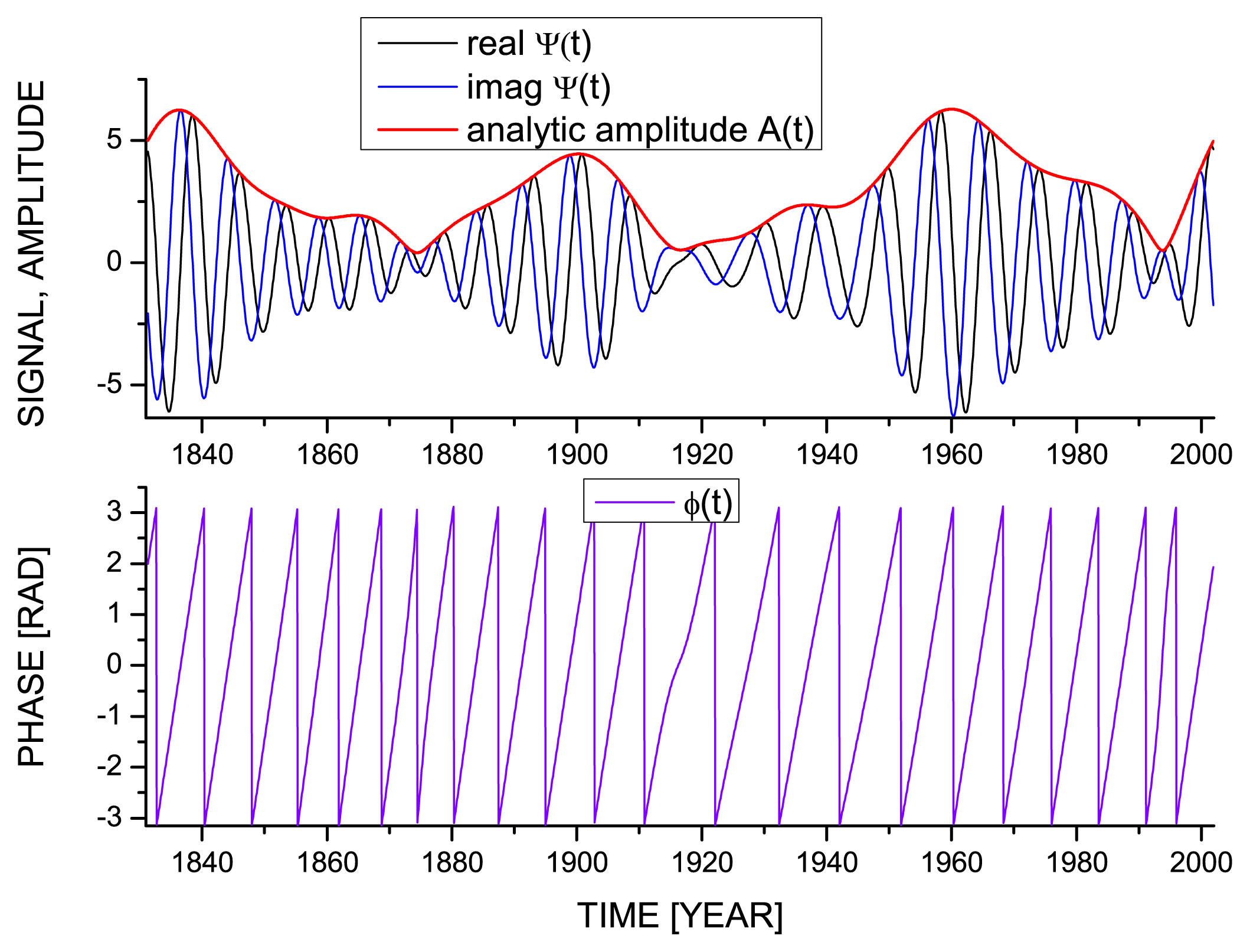
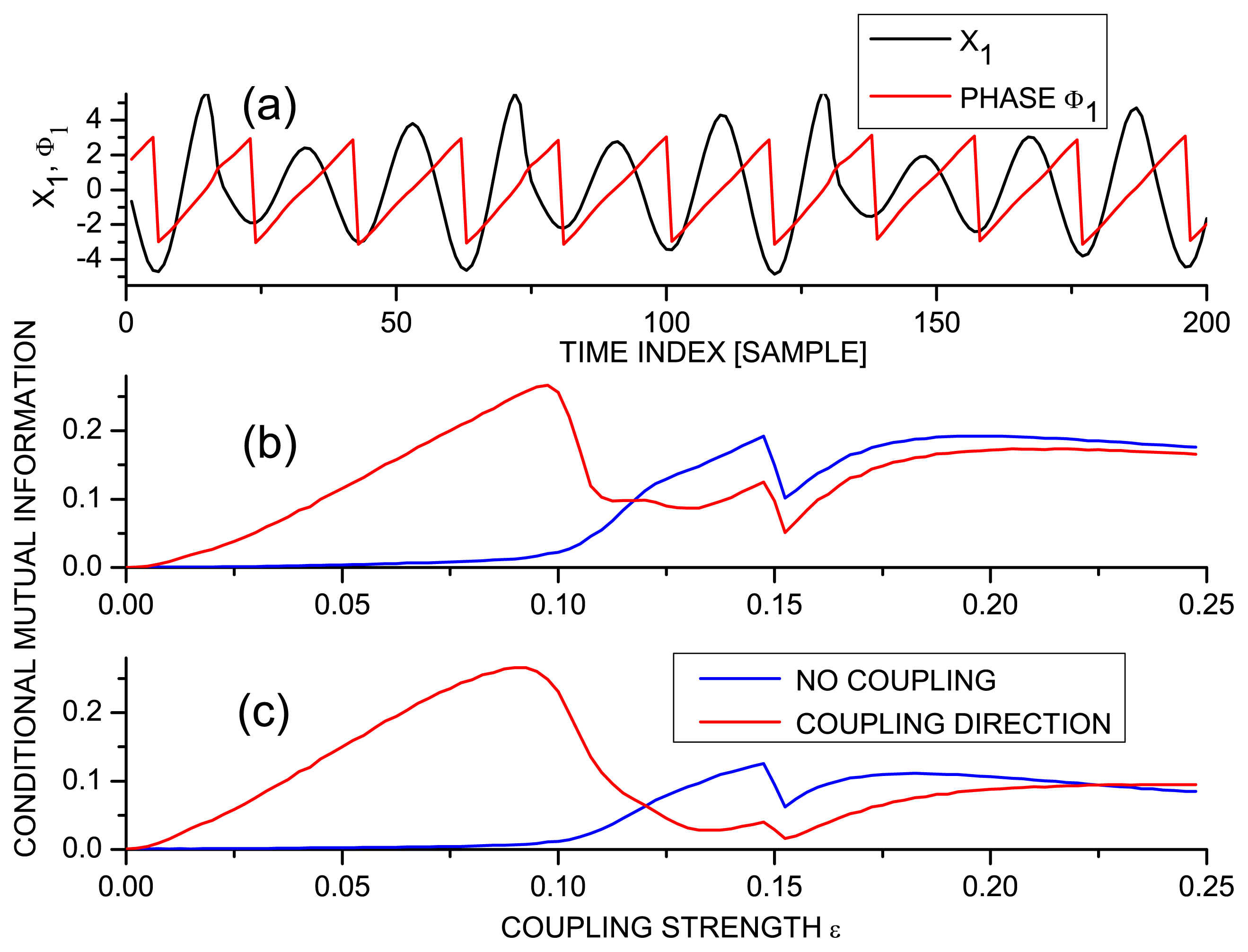
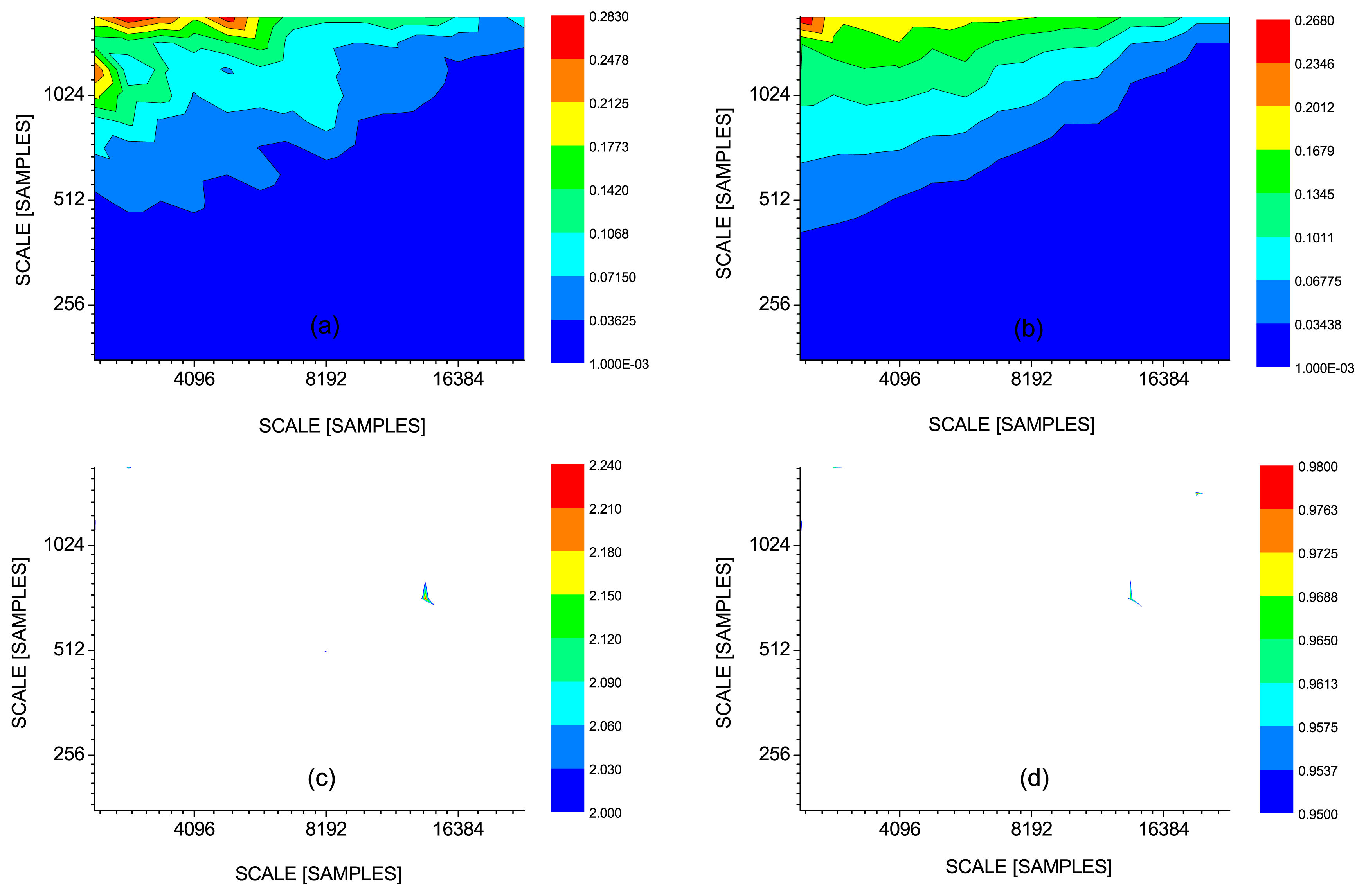

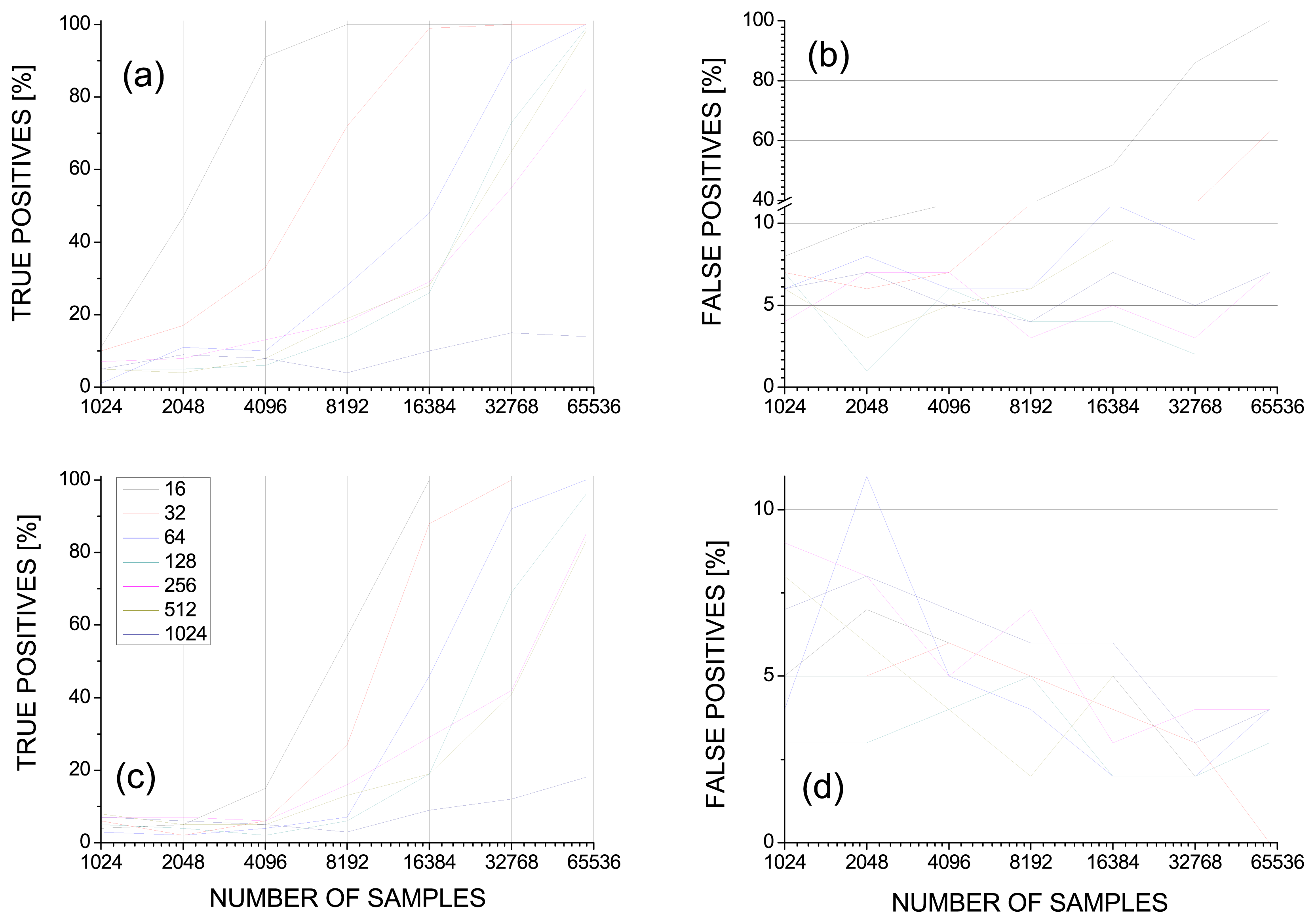
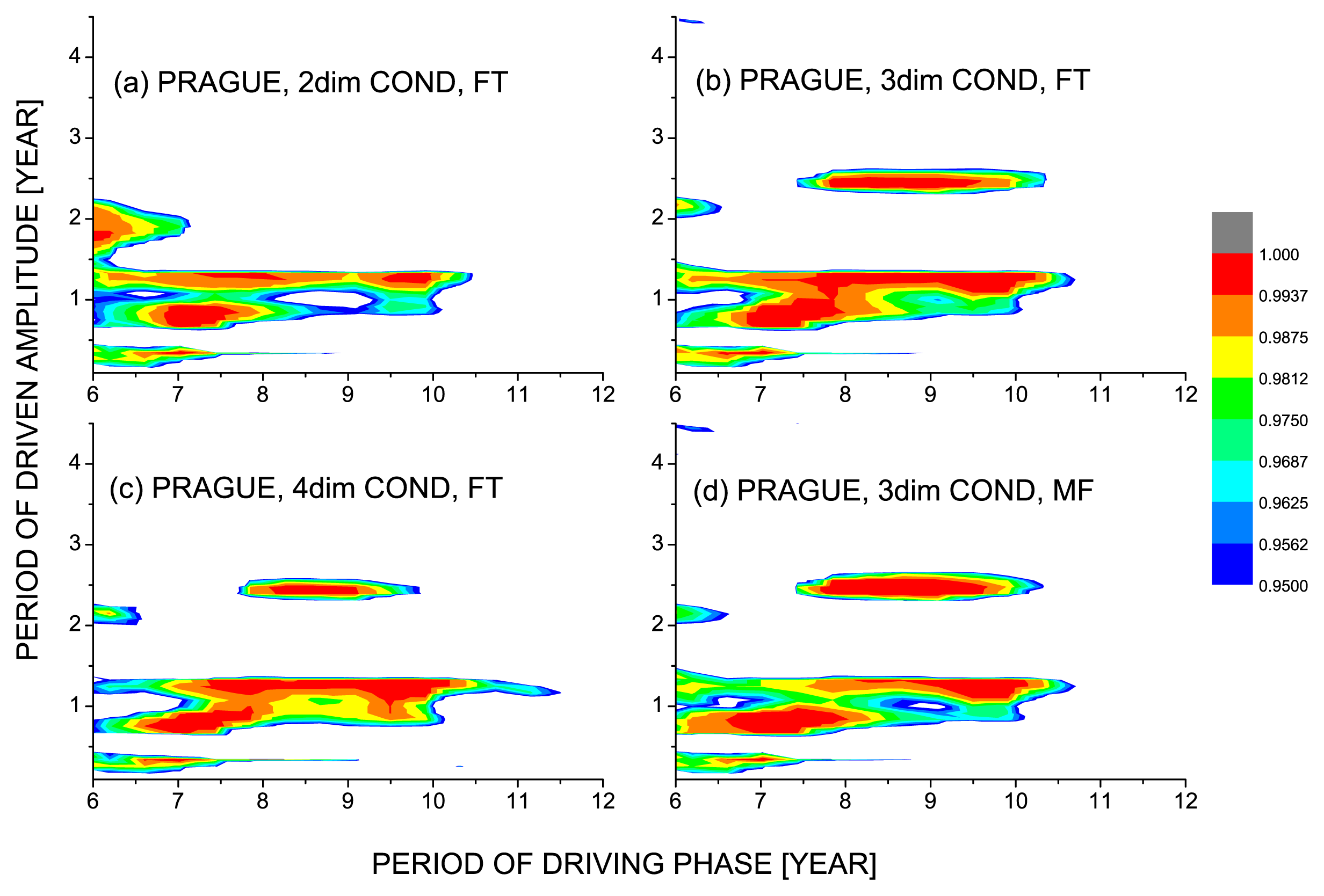
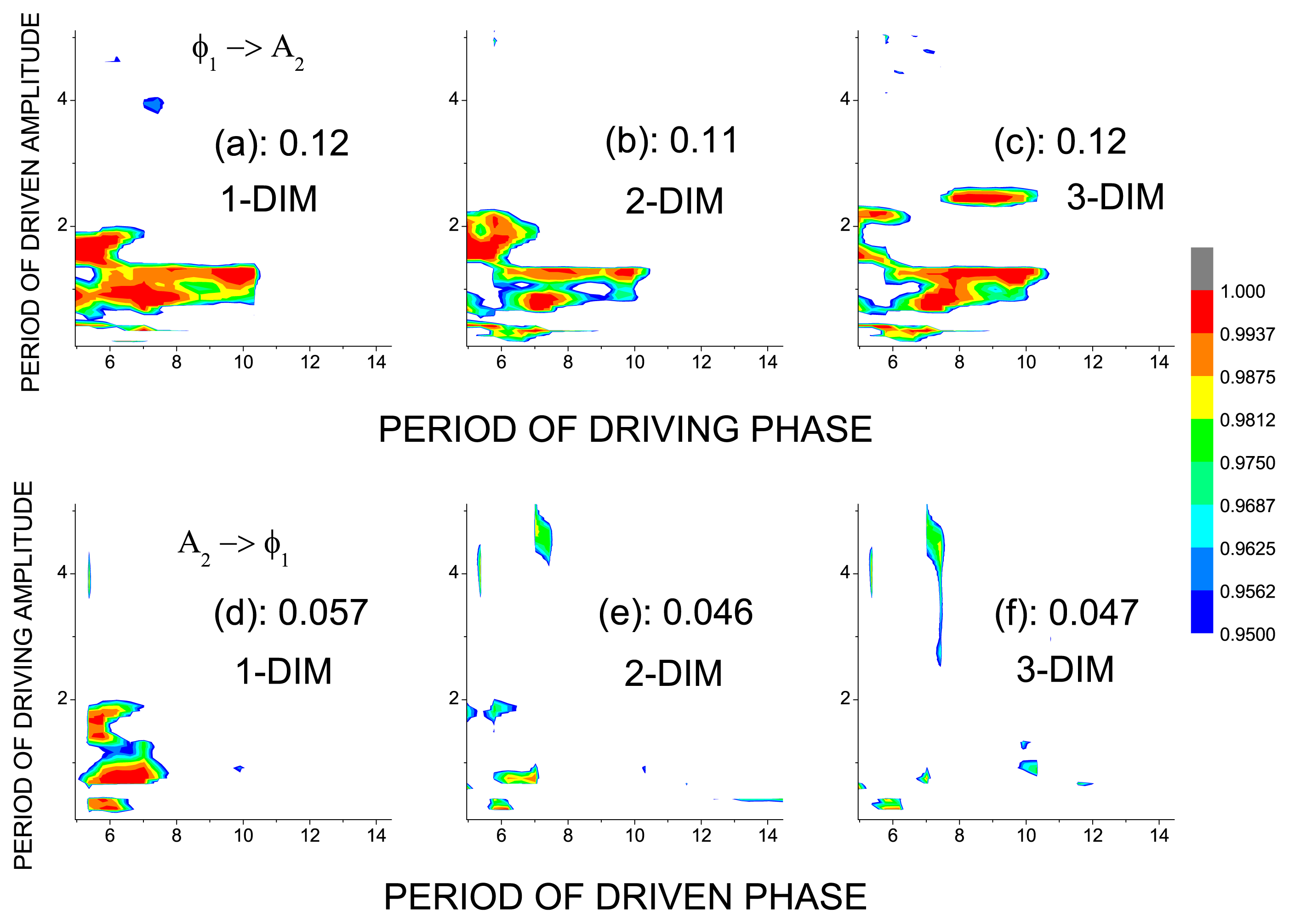
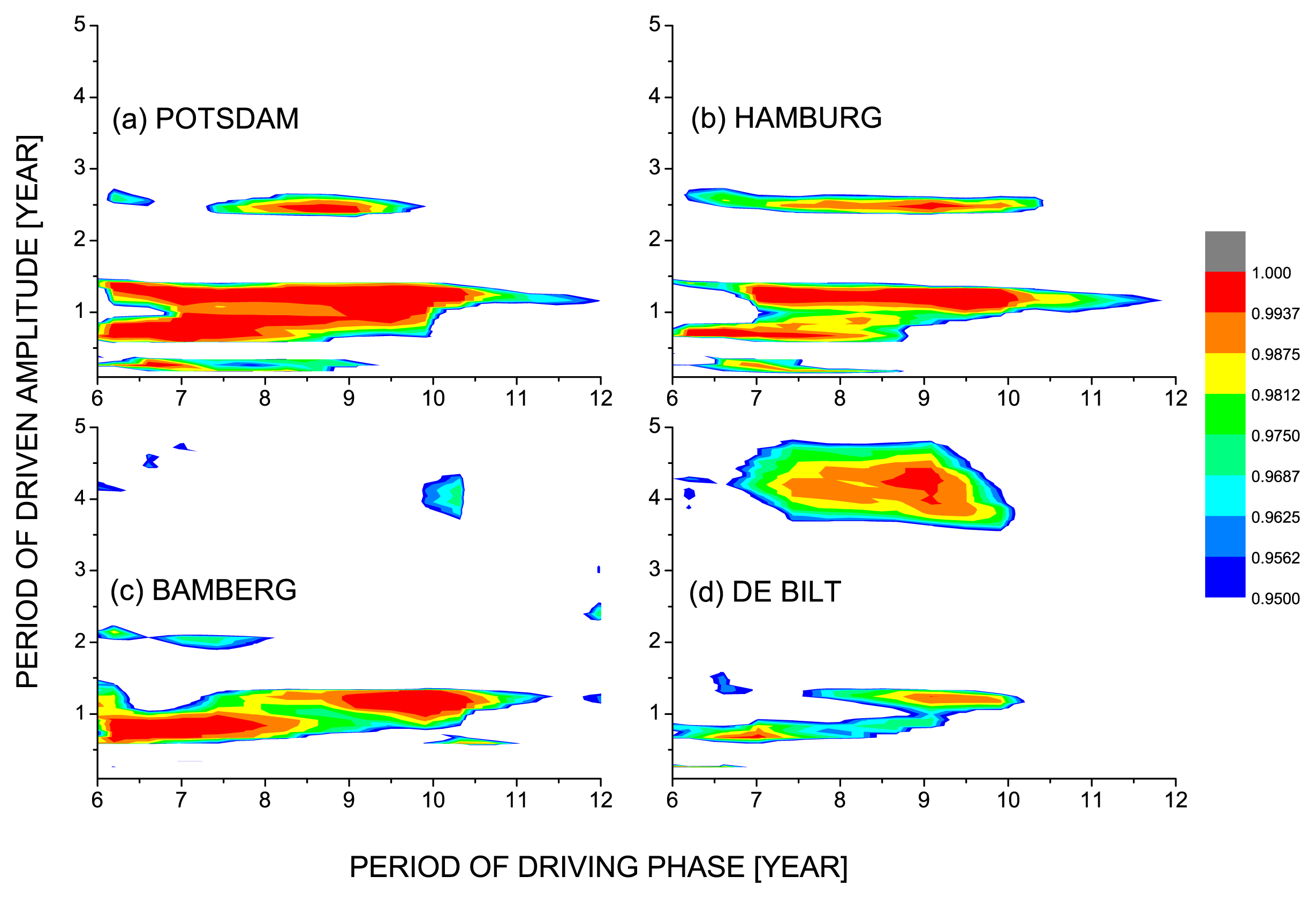


© 2014 by the authors; licensee MDPI, Basel, Switzerland This article is an open access article distributed under the terms and conditions of the Creative Commons Attribution license (http://creativecommons.org/licenses/by/3.0/).
Share and Cite
Paluš, M. Cross-Scale Interactions and Information Transfer. Entropy 2014, 16, 5263-5289. https://doi.org/10.3390/e16105263
Paluš M. Cross-Scale Interactions and Information Transfer. Entropy. 2014; 16(10):5263-5289. https://doi.org/10.3390/e16105263
Chicago/Turabian StylePaluš, Milan. 2014. "Cross-Scale Interactions and Information Transfer" Entropy 16, no. 10: 5263-5289. https://doi.org/10.3390/e16105263
APA StylePaluš, M. (2014). Cross-Scale Interactions and Information Transfer. Entropy, 16(10), 5263-5289. https://doi.org/10.3390/e16105263



